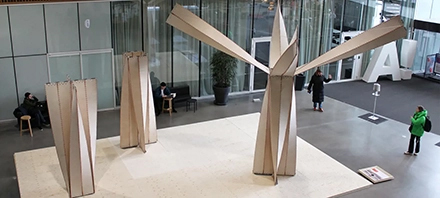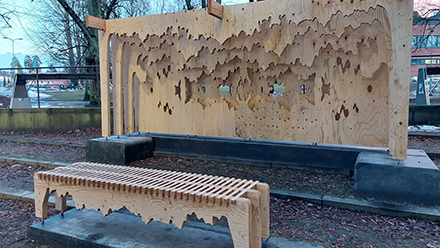UPM Plywood is involved in innovative projects to explore the properties and applications of materials together with universities. Of the two Aalto University collaborative projects, the outdoor art piece Quantum Moss represents a slightly unusual collaboration due to its scientific-artistic origins, while the 20×4 Twist project explores the properties of plywood in an atypical structure. Source: Timberbiz
The 20×4 Twist exhibition and research was inspired by an interdisciplinary course for architecture students and designers to design structures that would achieve lightness, adaptability, re-assemblability and demountability, inspired by the quest for zero emissions in construction. The above themes were explored in the course’s final exhibition Zero Gravity in 2019.
Later, some students from the Department of Architecture started to explore the relationship between flexible plywood, architectural geometry, structural behaviour and aesthetics.
“We were contacted and thought that our products, material knowledge and calculation skills could be useful for further research,” said Simo Koponen, Senior Researcher in Product and Material Development at UPM Plywood.
The exhibition and research, called 20×4 Twist, are part of a doctoral thesis. Plywood elements were used to create different architectural spaces, such as frames and sponge-like structures, which can be used as structures for different exhibitions.
These self-supporting plywood structures used shapes bent from 6.5-millimetre WISA Birch birch plywood, joined together by punching holes in the plywood and using a type of rivet or other fasteners. Their light weight and demountability allow the structures to be stored and reused. Both the structure and its recyclability are seen as having the potential to reduce material consumption.
UPM Plywood provided plywood for the study, and Koponen contributed to the development of the calculation methods, including the calculation of bending elongations.
“Due to its lightness and strength, plywood is also an excellent material for this type of construction. We gained valuable insight into how plywood performs in a new type of demanding structure,” said Koponen, summing up the collaboration.
UPM Plywood’s expertise and material know-how were also used in the Quantum Moss cloud artwork. The work depicting quantum phenomena won an art competition at Aalto University.
The plywood work was installed near the Aalto University metro entrance in Otaniemi in autumn 2023. Quantum Moss, the result of a multidisciplinary collaboration, is a pergola-like structure that provides a resting place for campus users and at the same time a habitat for campus wildlife.
Designed by Aalto University student Noora Archer and researcher Laura Piispanen, the outdoor artwork is made of 50 mm thick spruce plywood. Its formal language is based on a numerical simulation of the probability distribution of a quantum mechanical particle’s position in time and combines quantum technology research and wood construction.
According to Sami Uuksulainen, Director, Product Management & Development at UPM Plywood, the interdisciplinary concept of the work attracted the interest of the plywood community. They helped with strength calculations, material engineering and procurement, and consulting on machining, among other things.
“Our role in the making of this work of art combining design and quantum mechanics was mainly technical. However, interdisciplinary projects like this also feed our innovative spirit. New knowledge and learning can potentially lead to new projects and research,” said Uuksulainen.







